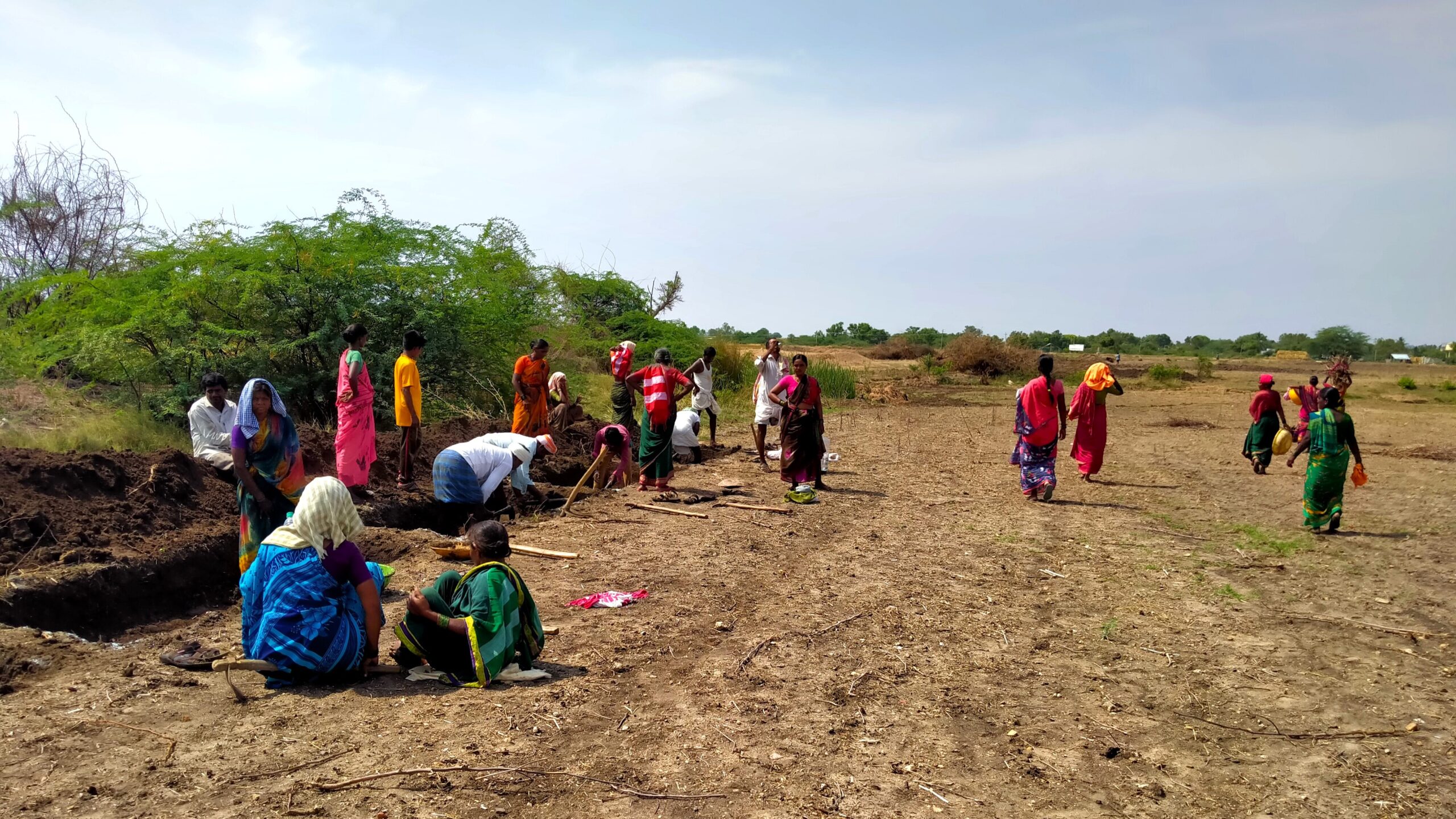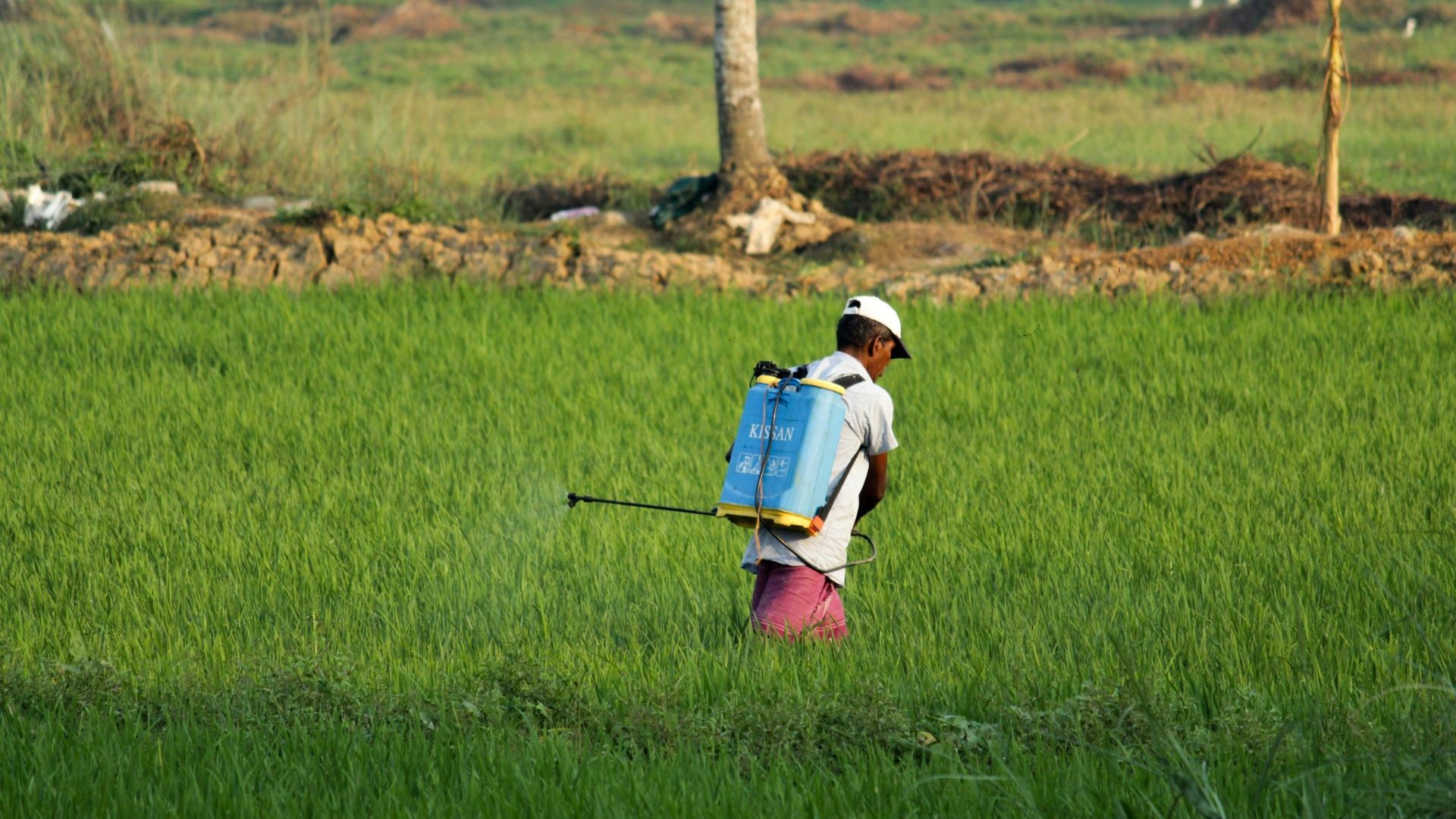A People-Centric Approach to Tackling Poverty in India
Nature-based solutions like carbon offsets should prioritize people, encompass entire landscapes, and align with poverty alleviation objectives.
Devaraya* is aghast at his crop yield. Situated in the city of Devadurga, in the southern Indian state of Karnataka, he barely recovered the input costs for his primary crop in the monsoon season (Kharif crops). Spare a few patches where the winter crop, pearl millet (also called Bajra) thrived, large swathes of his two-acre farm faced stunted or no growth.
We met him in January of 2023, and he told us that this poor yield is the latest in a string of setbacks. In June 2022, Devaraya sold all his livestock for Rs. 80,000 (approximately 887 Euros) to buy a pump set to draw water from a nearby canal. This way he figured he would be able to irrigate his fields better and improve yield. However, he still ran into a net loss on his cotton produce –one of the main cash crops in this region of India.
Devaraya’s land is undergoing degradation and will need a range of long-term interventions to increase crop yield. This will take time, time he cannot afford as his profits plummet, and he is forced to spend more for water, fertilizers, and other inputs. He might have to look for alternative income – probably through short-term labor work, such as the kind offered through government-funded programs like the flagship Mahatma Gandhi National Rural Employment Guarantee Scheme (MGNREGS). A one-time project that puts more cash in hand would be welcome, but would it be enough to help him escape this cycle of debt and improve his overall well-being?

Devaraya’s story is one that echoes across the degraded landscapes of Raichur district, where Devadurga is located. Our conversations with other farmers in the region and with grassroots organization, Prarambha, showed that hefty investments in projects with a narrow focus do little to alleviate poverty in the long run, or to solve larger issues plaguing rural communities here.
Hefty investments in projects with a narrow focus do little to alleviate poverty in the long run
As climate change aggravates existing risks, it is necessary to question whether siloed, project-based interventions aimed at income generation are enough to service the needs of the poor, or should the focus be shifted to livelihoods as a whole. This is a decades-old debate, made even more relevant now by the push for nature-based solutions, such as carbon-offset projects, that are inching closer towards providing cash in hand with limited emphasis on improving overall quality of life.
Even as the buzz around such solutions continues to grow, real poverty indicators remain in decline. In a recent series of articles, welfare economist Jean Drèze analyzed the growth in real wages for India. Between 2014 and 2021, for India’s laborers, wages have increased by less than 1 percent across agriculture, construction, and non-agricultural sectors. For these eight years, the average consumer price inflation stood at 6 percent. This means that the ability of the poor to be able to save and spend on improving their quality of life is severely hampered, despite the availability of income-enhancing programs like the MNREGS.
Between 2014 to 2021, for India’s labourers, wages have increased by less than 1 percent across agriculture, construction and non-agricultural sectors.
Wages are important, and the dire need for steady income cannot be understated, but so far, measures have failed to account for inflation and related adjustments, essentially making income-enhancing programs far less effective than they were. For such programs to truly help the poor, the incomes they generate must keep pace with inflation, if not surpass it, besides providing stability against crises. This is where the distinction between incomes and livelihoods becomes relevant.
What does a focus on livelihood mean for poverty alleviation?
A deeply held bias in terms of measuring the impact of development programs on poverty alleviation has tilted towards stipends, subsidies, and income enhancement. Many of these programs, including philanthropic and CSR initiatives, adopt a ‘project approach’. This involves providing resources to address one specific problem that may help improve current living conditions like clean drinking water. These are necessary and critical.
However, without long-term commitments to a landscape or its people, these projects do little for livelihood enhancement – improved nutrition, energy/fuel access and other factors that enhance the overall quality of life – which, in turn, helps break the cycle of intergenerational poverty.
Without long-term commitments to a landscape or its people, these projects do little for livelihood enhancement.
Take the case of Raichur, where Devaraya and others like him grapple with land degradation and rural distress. It is the rice and cotton bowl of the state and one of the top three consumers of pesticides and fertilizers. Irrigation projects meant to service drought-proofing north of Raichur have also been implemented here.

However, water doesn’t reach the tail end (farthest from the dam or source of water). Moreover, Raichur also reports levels of anemia and malnourishment that are above the national average, falling behind on nutritional security and healthcare infrastructure. There’s a visible paradox of lush fields of rice, cotton, and chilli alongside rampant distress migration among the lower and landless classes. Clearly, efforts have been made and some much-needed income has been generated, but without solving larger issues or effectively alleviating poverty.
This came through in the aspirations study we conducted with 200 farmer households in three villages in Raichur. Through interviews and focus group discussions, we wanted to account for local preferences and needs, and understand what is driving trends such as distress migration. People told us that they wanted more work under MGNREGS, better education and healthcare facilities, and local employment. People want not only monetary income but also freedom from discrimination, financial buffers against shocks such as extreme weather events, as well as opportunities for progress.
People want not only monetary income but also freedom from discrimination, financial buffers against shocks such as extreme weather events, as well as opportunities for progress.
The study reinforces that poverty alleviation needs more than income enhancement, which becomes myopic after a point. It provides economic stability for a few certain and anticipated life events but does not provide a safety net from uncertainties that can heavily erode savings of households.
The absence of these safety nets was starkly evident during the COVID-19 pandemic, which saw a mass exodus of people to rural areas, collapse of healthcare systems, and a spike in demand for MGNREGS employment by nearly 40 percent compared to pre-pandemic levels, shooting up to almost 225 percent in the peak months.
Poverty alleviation will have to be fostered by access to healthcare, education, ecosystem services and other social and cultural needs.
Discussions around a livelihood-based approach are not new. Economist and Nobel laureate Amartya Sen’s seminal work published in 1999, Development as Freedom, paved the way for recognizing that poverty alleviation will have to be fostered by access to healthcare, education, ecosystem services, and other social and cultural needs necessary for improving the quality of life.
Nature-based solutions is no magic wand
We talked about the larger debate between income-enhancement and livelihood-based approaches. But there’s another layer of complexity when we situate it against the climate crisis and the influx of funds to address its impacts. The excitement around nature-based solutions, like afforestation projects, is reaching cacophonic levels. Though well-intentioned, these projects are also leaning towards putting more cash in hand than overall quality of life.
Take the case of carbon financing mechanisms for afforestation, which promise money to its beneficiaries through the sale of carbon credits in the voluntary trading market. Here, income earned per hectare of investment in carbon sequestration projects is a measure of success. But this largely ignores the demographics of beneficiaries and other variables affecting quality of life. For instance, a series of studies that tracked investments over 50 years in India’s mountainous, northern state of Himachal Pradesh, found that for every rupee invested in such projects, benefits worth only 0.40 paise were secured locally (for perspective: one Indian Rupee comprises 100 paise). This means that the benefit generated from the investment was significantly lower than the amount invested.
70% of Indian households depend on agriculture to support themselves
This is worrying. The natural environment is central to the sustenance of most of the population 70% of Indian households depend on agriculture to support themselves. Yes, it is critical to restore degraded landscapes for people and the planet, but this is a long-term process that could take a decade or two, depending on the extent of degradation. It requires careful planning and iterative implementation, and there’s an opportunity here to go beyond the narrow lens of income enhancement.
A more holistic approach would address the challenges that prevent people from improving their quality of life. For example, take two seemingly disconnected issues: a medical emergency and the non-availability of fodder. The former erodes household incomes, and the latter impedes supplementary occupations such as livestock rearing. Only the latter is linked to degraded landscapes and loss of natural vegetation. This might suggest that restoration efforts focusing on agroforestry or providing fodder address certain issues but overlook others, such as limited access to safe drinking water or affordable healthcare facilities, which are crucial for resilience against emergencies like medical crises.
Such an integrated approach may appear to be a magic bullet solution as many institutions in the landscape tend to address a specific challenge such as providing cooking stoves, sanitation, or adding value to local produce. However, a single-lens approach to nature-based solutions may be inadequate.
Collaborating to co-design pathways
The aspirations study we conducted showed the importance of understanding people’s needs in order to build trust and configure solutions with people, as opposed to parachute solutions geared towards meeting simplistic targets. This is a herculean task that requires government machinery, a network of grassroots institutions, and local people to collaboratively decide what livelihood security would look like for their landscape, based on past experiences, current needs, and future threats.
This is a herculean task that requires government machinery, a network of grassroots institutions and local people to collaboratively decide what livelihood security would look like.
The framework for such collaboration exists but needs to be strengthened. The Indian Constitution mandates decentralization of governance for development. Over time, however, many of these bodies have been rendered ineffective for lack of resources and a clear governance objective. This includes several formal and informal resource groups under the Gram Panchayat, such as the village committees, watershed committees, water user committees, self-help groups, and biodiversity management committees.
In this backdrop, the role of civil society becomes vital. A network of cooperatives and farmer producer organisations may also be able to service local demand for overall livelihood security. These institutions have faced their share of obstacles, but collaborating across landscapes can enable them to provide knowledge dissemination, public engagement, building local capacity on essential skills and on-ground implementation with people. This cooperative partnership model would primarily focus on people’s aspirations, nudging behavioural change systematically.
A bottom-up approach, driven by the affected communities, can ensure that civil society resources are directed to achieve tangible results.
This is not to say that the work done by non-state actors can substitute for the government. A stronger civil society simply helps direct public finance better, ensuring last-mile access for government services. A bottom-up approach, driven by the affected communities, can ensure that civil society resources are directed to achieve tangible results, instead of settling for weekend tree-planting projects.
Current development models are missing the forest for the trees. Through collaborations and a landscape approach that pushes for overall livelihood security over shorter-term benefits, farmers like Devaraya will be able to earn better, be protected against risks, and be able to realize their aspirations.
*Please note names have been changed to protect their identities.
